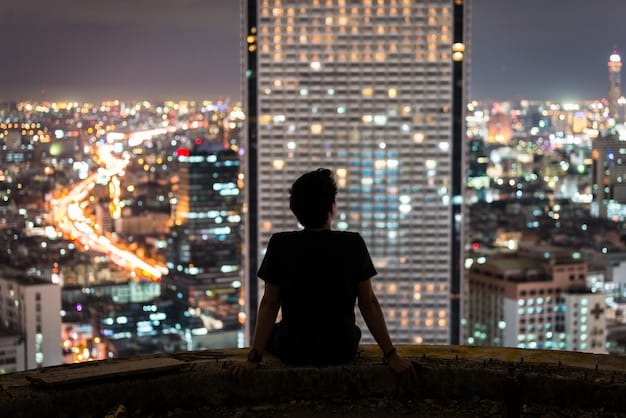Managing Anxiety in Uncertainty: US Resident Strategies

For US residents grappling with the pervasive uncertainty of modern life, effectively managing anxiety involves integrating practical coping mechanisms, fostering resilience, and seeking professional support when necessary to maintain mental well-being and stability.
Living in an uncertain world can feel like navigating a constantly shifting landscape, and for many US residents, this pervasive unpredictability brings heightened levels of anxiety. Understanding how to soothe this unease is not just a personal quest but a vital skill for collective well-being. This article delves into robust, evidence-based strategies for Managing Anxiety During Times of Uncertainty: Strategies for US Residents, offering practical tools and insights to cultivate resilience and find calm amidst the storm.
Understanding the Landscape of Anxiety in the US
Anxiety is a natural human response to stress and perceived threats. However, in an era marked by rapid societal changes, economic fluctuations, health crises, and political divisiveness, many US residents experience a chronic state of heightened anxiety that transcends typical stress responses. This section explores the multifaceted nature of anxiety in contemporary America.
The prevalence of anxiety disorders has seen a notable increase, particularly among younger generations. Factors such as information overload from constant news cycles, the pressure of social media, and evolving workplace demands contribute significantly to this mental health challenge. It’s crucial to acknowledge that anxiety, while often debilitating, is a treatable condition, and recognizing its roots is the first step toward effective management.
Societal Factors Fueling Anxiety
Several macro-level trends contribute to the anxiety landscape in the US. Economic instability, characterized by inflation, job market shifts, and housing affordability crises, creates significant financial stress. The political climate, with its often contentious debates and rapid policy changes, can also foster a sense of unease and division, leaving individuals feeling powerless.
- 📈 Economic pressures: Rising cost of living, stagnant wages, job insecurity.
- ⚖️ Political divisiveness: Polarized discourse, social unrest, distrust in institutions.
- 🌐 Digital overload: Constant connectivity, social media comparison, fear of missing out.
- 🌍 Environmental concerns: Climate change, natural disasters, impact on future generations.
Beyond these, global events, from pandemics to international conflicts, project a shadow of unpredictability that can feel overwhelming, emphasizing our interconnectedness and vulnerability. Understanding that these systemic factors contribute to individual anxiety can help us contextualize our feelings and seek appropriate strategies.
Individual Manifestations of Anxiety
Anxiety doesn’t manifest uniformly. For some, it might be a persistent worry about future events, while for others, it could be physical symptoms like heart palpitations, sleep disturbances, or digestive issues. The individual experience is deeply personal, influenced by genetic predispositions, personal history, and coping mechanisms learned over time.
Recognizing your unique anxiety triggers and how they manifest is key. Is it the morning news, a particular financial discussion, or social gatherings that heighten your unease? Keeping a journal can be an effective way to track these patterns and gain self-awareness. This introspective process is foundational for tailoring effective management strategies.
Establishing Daily Routines and Predictability
In times of uncertainty, the external world may feel chaotic, but establishing a predictable internal world can be a powerful antidote to anxiety. Daily routines provide a sense of structure, control, and normalcy, which are anchors in turbulent times. This section will explore how cultivating predictable habits can significantly reduce anxiety levels for US residents.
Humans thrive on routine. Our brains interpret predictability as safety. When external events are unpredictable, creating a stable internal environment through consistent daily practices can help regulate the nervous system, lower cortisol levels, and promote a sense of calm. This isn’t about rigid adherence but about building a comforting rhythm.
The Power of a Morning Ritual
Starting the day with purpose and calm can set a positive tone. Many people find that a consistent morning routine helps ground them before engaging with the day’s uncertainties. This doesn’t need to be elaborate; even 15-30 minutes dedicated to personal well-being can make a significant difference. Consider what activities bring you peace and focus.
- 🧘 Morning meditation or deep breathing exercises.
- 📓 Journaling thoughts and setting intentions.
- 🚶 Brief walk or light exercise to energize the body.
- 📚 Reading a book or listening to calming music instead of immediately checking news.
The goal is to intentionally create space for self-care before the demands of the day begin. This proactive approach helps build resilience, preparing you to face challenges with a clearer mind and a more composed spirit. It’s about taking control of the first moments of your day rather than allowing them to be dictated by external pressures.
Integrating Predictability Throughout the Day
Extending routines beyond the morning fosters continued stability. This could involve scheduling regular breaks, dedicating specific times for work tasks, or planning healthy meals. The consistency reinforces a feeling of order, counteracting the disorienting effects of uncertainty. Even small, predictable actions add up.

For example, scheduling a “news-free” window in the evening can prevent overwhelming information consumption before bed. Designating a specific time for phone calls or emails can help manage digital distractions. These structured moments create mental boundaries, preventing intrusive thoughts and anxious rumination.
Similarly, a consistent sleep schedule – going to bed and waking up at roughly the same time each day, even on weekends – is paramount. Sleep deprivation exacerbates anxiety, while sufficient rest supports emotional regulation and cognitive function. Prioritizing sleep is a non-negotiable component of an anxiety-reducing routine, creating a predictable end and beginning to each day.
Mindfulness and Grounding Techniques
Mindfulness is the practice of being present in the moment, observing thoughts and feelings without judgment. Grounding techniques are simple exercises that help bring an individual’s focus to the present, especially during moments of intense anxiety or panic. For US residents navigating uncertainty, these practices offer immediate relief and long-term coping skills.
When anxiety spirals, our minds often jump to hypothetical future scenarios or dwell on past regrets. Mindfulness and grounding interrupt this cycle by gently redirecting attention to the here and now. They equip individuals with tools to observe their anxious thoughts rather than being consumed by them, fostering a sense of detachment and control.
Practical Mindfulness Practices
Mindfulness doesn’t require hours of meditation; it can be integrated into everyday activities. Simple exercises can help cultivate present-moment awareness, reducing the mind’s tendency to wander into anxious territory. The key is consistent, gentle practice, building the “muscle” of attention over time.
- 🌬️ Mindful breathing: Focus on the sensation of each inhale and exhale.
- 🍽️ Mindful eating: Pay attention to the taste, texture, and aroma of food.
- 🚶 Mindful walking: Notice the feeling of your feet on the ground, the sights, and sounds around you.
- 🧼 Mindful chores: Engage fully in tasks like washing dishes, focusing on the sensory experience.
These practices train the mind to stay anchored. By regularly bringing attention to sensory experiences, we can create pauses in our day, opportunities to step out of anxious thought patterns and connect with the tangible reality around us. This helps to reduce the feeling of being overwhelmed by external uncertainties.
Effective Grounding Techniques
Grounding techniques are especially useful when anxiety feels acute or overwhelming. They act as mental fast-breaks, re-engaging the senses and pulling the individual out of rumination or panic. They are quick, discreet, and can be used in almost any situation, offering immediate relief.
One popular technique is the “5-4-3-2-1” method: Name five things you can see, four things you can touch, three things you can hear, two things you can smell, and one thing you can taste. This sensory exercise strongly pulls your attention to your immediate surroundings, disrupting anxious thoughts and grounding you in the present.
Another simple technique involves focusing on a specific object in your environment. Describe its color, texture, shape, and function in detail. Or, try physically grounding yourself by pressing your feet firmly into the ground, noticing the sensation. Holding a piece of ice or splashing cold water on your face can also provide a sudden sensory shift, redirecting focus away from internal distress.
Fostering Connection and Community Support
Humans are inherently social beings, and strong social connections are a powerful buffer against anxiety, particularly during uncertain times. For US residents, given the vastness and diversity of the country, actively seeking and nurturing community support can be a lifeline. This section highlights the importance of connection and practical ways to build a supportive network.
When we feel isolated, our anxieties can intensify. Sharing our concerns with others, receiving empathy, and feeling understood can significantly alleviate the burden of worry. Community provides a sense of belonging, purpose, and mutual aid, critical components for mental well-being in periods of widespread uncertainty.
Building and Maintaining Social Ties
Even in a digitally connected world, genuine human connection requires intentional effort. Prioritizing face-to-face interactions, even if virtually, can make a significant difference. Reach out to friends, family, and colleagues, not just for practical reasons, but simply to connect and share experiences.
- 📞 Schedule regular video calls with loved ones residing far away.
- 🤝 Join local clubs or groups based on shared hobbies or interests.
- volunteer for causes you care about, meeting like-minded individuals.
- dine with neighbors or organize small, socially distanced gatherings.
Remember that quality often trumps quantity. A few deep, meaningful relationships can provide more support than many superficial ones. Don’t hesitate to initiate contact; many others are likely feeling similar needs for connection during uncertainty and would welcome the outreach.
Leveraging Online Communities Responsibly
While often criticized, online platforms can be valuable for fostering connection, especially for individuals with limited in-person social opportunities. Support groups, forums, and special interest groups offer spaces to share experiences, gain insights, and find solidarity. However, responsible use is key to avoiding further anxiety.
Seek out moderated groups focused on positive support or shared interests rather than those that might amplify fear or negativity. Limit your time on platforms that promote comparison or exacerbate feelings of inadequacy. The goal is to leverage the internet for connection, not for deepening social media-induced pressures or exposure to overwhelming news.
Actively participating in real-world community initiatives, such as local clean-up drives or neighborhood watch programs, can also create strong bonds. These activities foster a sense of collective purpose and efficacy, which can be incredibly empowering when individual control feels limited. Helping others also has a well-documented positive effect on one’s own mental health, redirecting focus outward and reducing anxious rumination.
Limiting Exposure and Curating Information
In our hyper-connected world, information overload and constant exposure to negative news can significantly fuel anxiety. For US residents, the 24/7 news cycle, social media feeds, and instant notifications make it challenging to escape dire headlines. This section provides strategies for curating information intake to protect mental well-being.
While staying informed is important, there’s a fine line between awareness and excessive consumption that leads to spiraling anxiety. Our brains are not designed to process a constant barrage of distressing information. Intentionally limiting and curating what we consume can reduce feelings of overwhelm and helplessness.
Establishing Information Boundaries
Think of your mind as a garden; you wouldn’t let weeds grow rampant. Similarly, be selective about what thoughts and information you allow into your mental space. This involves proactive steps to reduce exposure to anxiety-inducing content, particularly during sensitive times.
- ⏰ Schedule news consumption: Designate specific, limited times to check news, avoiding it before bed.
- 🔇 Mute distressing content: Utilize social media features to mute keywords or accounts that consistently post anxiety-inducing material.
- 🚨 Turn off notifications: Disable push notifications for news apps and social media to prevent interruptions and unsolicited updates.
- 📰 Choose reputable sources: Stick to a few trusted, balanced news sources rather than diverse, unverified outlets.
Being intentional about when, where, and how you consume information can give you a greater sense of control and significantly reduce constant low-level anxiety. It allows you to be informed without being consumed by fear or alarm.
Curating Your Digital Environment
Beyond news, our digital environments, especially social media, can be major sources of anxiety. Unfollowing accounts that trigger negative emotions, comparisons, or unrealistic expectations is a simple yet powerful act of self-care. Actively seek out and follow accounts that inspire, educate, or entertain in a positive way.

Consider implementing “digital detox” periods, even if for just an hour or a day. Stepping away from screens allows your mind to rest, reconnect with the physical world, and engage in non-digital activities that promote well-being. This recharges mental batteries and provides perspective.
Educate yourself on media literacy. Understand how algorithms work and how news is framed. This critical perspective helps you process information more objectively and less emotionally. Recognizing when a headline is designed to provoke fear, rather than convey factual information, can empower you to resist its impact on your anxiety levels.
Seeking Professional Support and Resources
While self-help strategies are invaluable, there are times when anxiety becomes unmanageable through personal effort alone. Recognizing when to seek professional support is a sign of strength, not weakness. For US residents, a wide array of mental health resources are available, from therapy to support hotlines, offering specialized guidance for managing anxiety during uncertainty.
Mental health professionals, such as therapists, counselors, and psychiatrists, are trained to provide evidence-based interventions for anxiety. They can help individuals understand the root causes of their anxiety, develop personalized coping strategies, and, if appropriate, explore medication options. Don’t hesitate to reach out if anxiety is significantly impacting your daily life, relationships, or overall well-being.
When to Consider Professional Help
It can be challenging to determine when anxiety crosses the line from a normal response to stress to a condition requiring professional intervention. Look out for these signs that indicate it might be time to seek help:
- Persistent, uncontrollable worry that interferes with daily activities.
- Significant changes in sleep patterns, appetite, or energy levels.
- Physical symptoms like stomachaches, headaches, or muscle tension despite medical checks.
- Avoidance of situations or activities due to fear or intense discomfort.
- Increased use of alcohol or drugs to cope with anxiety.
- Feelings of hopelessness or despair.
Therapy, particularly Cognitive Behavioral Therapy (CBT) and Acceptance and Commitment Therapy (ACT), has proven highly effective in treating anxiety disorders. These approaches teach individuals to identify and challenge negative thought patterns, manage distressing emotions, and align their actions with their values, even in the presence of anxiety.
Navigating Mental Health Resources in the US
Accessing mental health care can sometimes feel complex, but numerous resources are available. Start by speaking with your primary care physician, who can provide referrals, conduct an initial assessment, and rule out any underlying medical conditions mimicking anxiety symptoms.
Consider utilizing online therapy platforms, which have expanded significantly and offer convenient access to licensed professionals from the comfort of your home. Many insurance plans cover mental health services, so it’s advisable to check your policy details. For those without insurance or facing financial constraints, community mental health centers, university clinics, and non-profit organizations often offer sliding-scale fees or free services.
National helplines and crisis lines provide immediate support and resources for those in distress. The Suicide & Crisis Lifeline (dial or text 988) offers 24/7 support for mental health crises. Organizations like the Anxiety & Depression Association of America (ADAA) and the National Alliance on Mental Illness (NAMI) also provide extensive information, support groups, and directories of mental health professionals across the US.
Building Resilience and Long-Term Well-being
Managing anxiety during uncertainty is not just about coping; it’s also about building long-term resilience. Resilience is the capacity to recover quickly from difficulties; toughness. It’s the ability to bounce back, adapt, and thrive even in the face of adversity. For US residents, cultivating this mental fortitude is essential for sustained well-being amidst evolving challenges.
Resilience isn’t an innate trait but a skill that can be developed through consistent practice and mindful self-awareness. It involves fostering a positive mindset, embracing flexibility, and continuously learning from experiences. This section outlines key elements for developing lasting resilience against anxiety during unpredictable times.
Cultivating a Growth Mindset
Adopting a growth mindset—believing that abilities and intelligence can be developed through dedication and hard work—is fundamental to resilience. Instead of viewing challenges as insurmountable threats, a growth mindset sees them as opportunities for learning and personal development. This perspective shift can significantly reduce the paralyzing effect of uncertainty.
- Embrace challenges as learning opportunities.
- View setbacks as temporary, not permanent.
- Focus on effort and persistence, not just outcomes.
- Learn from constructive criticism and feedback.
This approach fosters optimism and agency, empowering individuals to tackle difficulties head-on rather than being overwhelmed by them. It’s about reframing potentially anxiety-inducing situations into opportunities for growth and adaptation.
Prioritizing Physical Health
The mind and body are inextricably linked. Neglecting physical health can exacerbate anxiety, making it harder to cope with uncertainty. Conversely, a healthy body supports a resilient mind. Regular exercise, balanced nutrition, and adequate sleep are not just general health recommendations but crucial components of an anxiety management strategy.
Physical activity, even moderate exercise like walking, releases endorphins, natural mood lifters. A nutritious diet provides the brain with the fuel it needs for optimal function, while processed foods and excessive sugar can worsen anxiety symptoms. Prioritizing consistent, quality sleep further stabilizes mood and enhances cognitive function, making you better equipped to handle stress.
Moreover, spending time in nature has been widely recognized for its calming effects. Even short stints in a park or green space can reduce stress hormones and improve mood. For urban US residents, seeking out local parks, trails, or even creating a small indoor garden can provide vital connections to the natural world, fostering peace and mental clarity.
| Key Strategy | Brief Description |
|---|---|
| 🗓️ Establish Routines | Create predictability in daily life to counter external chaos and foster a sense of control. Essential for mental stability. |
| 🧘 Practice Mindfulness | Utilize grounding techniques to stay present, observe thoughts without judgment, and reduce immediate anxiety. |
| 🤝 Foster Connection | Nurture social ties and community support, leveraging human connection as a powerful buffer against isolation and worry. |
| 🧠 Seek Professional Help | Recognize when anxiety becomes unmanageable and access specialized therapies or support, a sign of strength and self-care. |
Frequently Asked Questions
Anxiety during periods of uncertainty often stems from a lack of control and predictability. Factors like economic instability, political shifts, health crises, and constant news exposure contribute to a heightened sense of threat and concern for the future, triggering our natural stress responses and leading to chronic worry.
Establishing daily routines provides a sense of structure and normalcy, which counteracts external chaos. Predictable habits signal safety to the brain, helping to regulate the nervous system, reduce stress hormones like cortisol, and create an internal sense of control, even when external circumstances are unpredictable.
Simple mindfulness techniques like focused breathing (paying attention to each inhale and exhale) or the “5-4-3-2-1” grounding method (identifying five things you see, four you feel, etc.) can bring immediate relief. These practices redirect attention to the present moment, interrupting anxious thought spirals and promoting calm.
Consider professional help when anxiety significantly interferes with daily life, relationships, or work, or if physical symptoms like sleep disturbances or persistent worry become unmanageable. If self-help strategies are insufficient, a therapist or counselor can offer evidence-based interventions and personalized coping strategies.
Strong social connections reduce anxiety by providing a sense of belonging, empathy, and mutual support. Sharing concerns with others can alleviate the burden of worry, reduce feelings of isolation, and offer different perspectives, reinforcing that you’re not alone in facing challenges during unpredictable times.
Conclusion
Navigating times of profound uncertainty is an inherent part of the human experience, yet it presents unique challenges for US residents today. Effectively managing anxiety in this environment requires a multi-faceted approach, integrating practical coping mechanisms, building robust daily structures, and maintaining vital social connections. From the grounding practice of mindfulness to the proactive choice of seeking professional support, each strategy contributes to a more resilient and calmer self. By embracing these tools, individuals can cultivate inner peace and face future challenges with greater equanimity, transforming moments of trepidation into opportunities for profound personal growth and enduring well-being.





